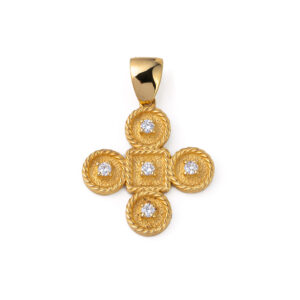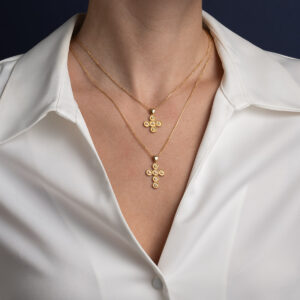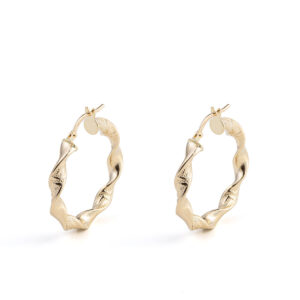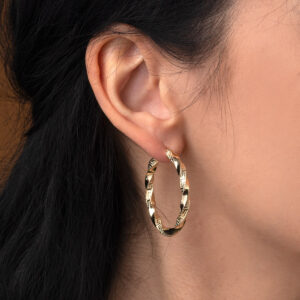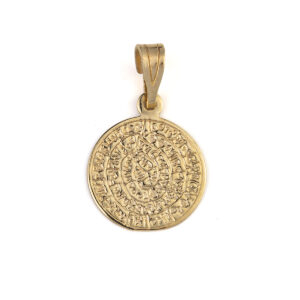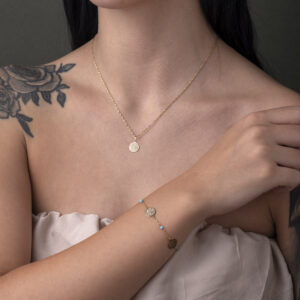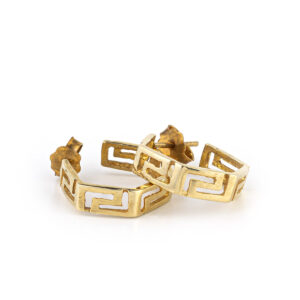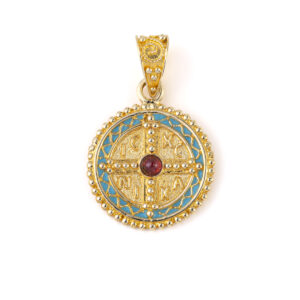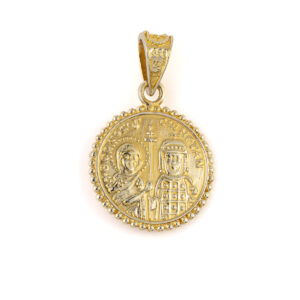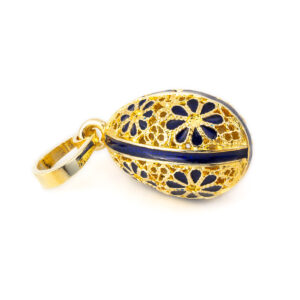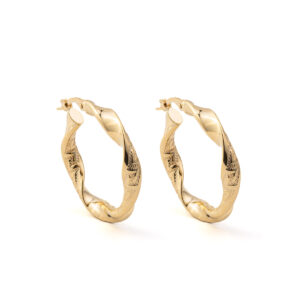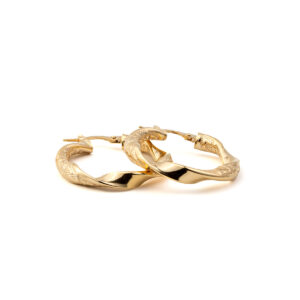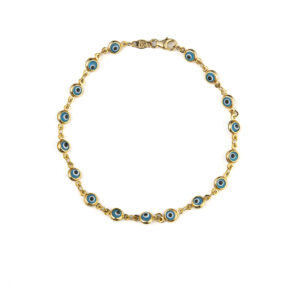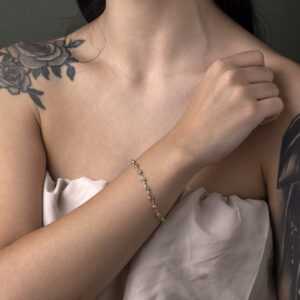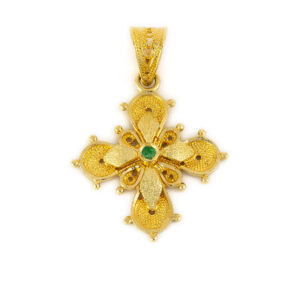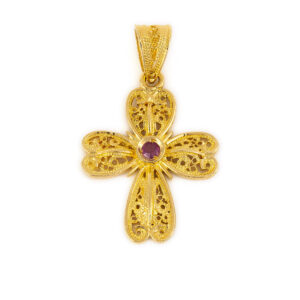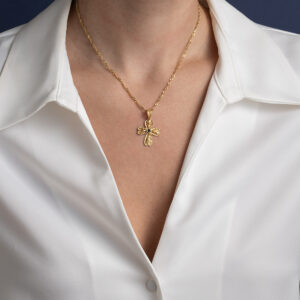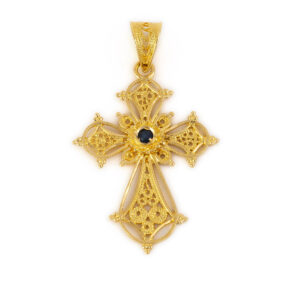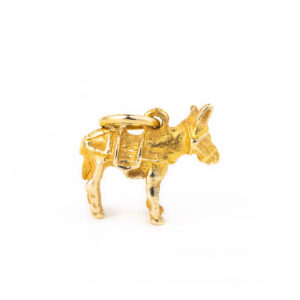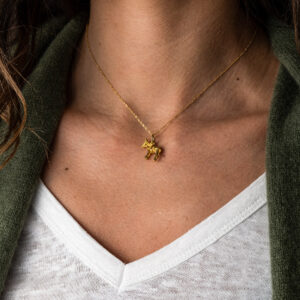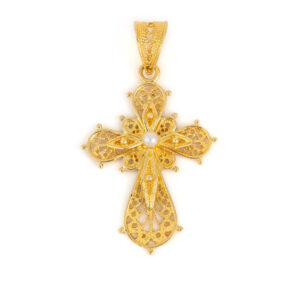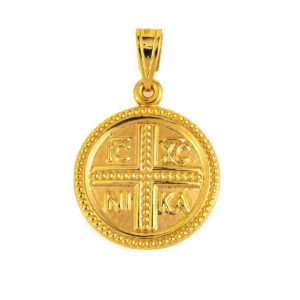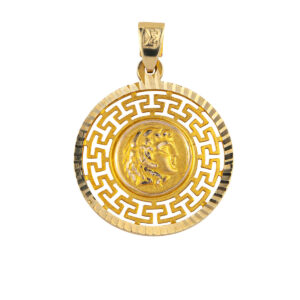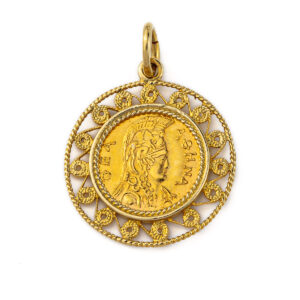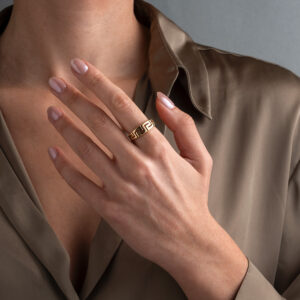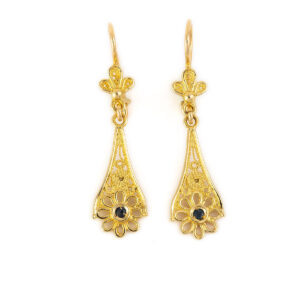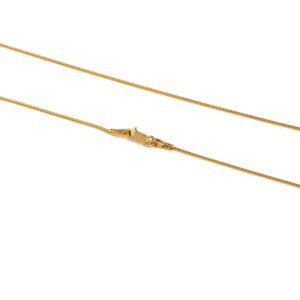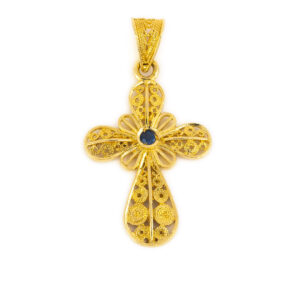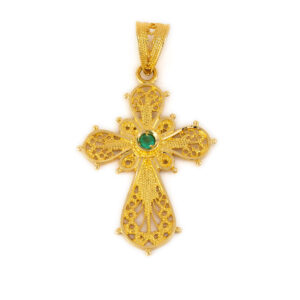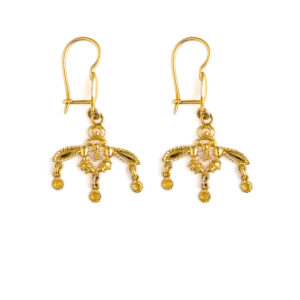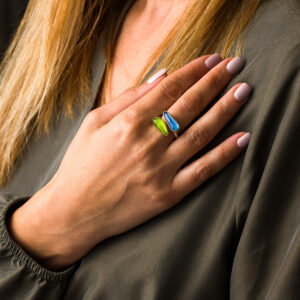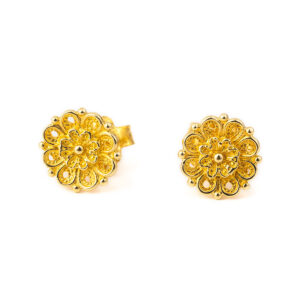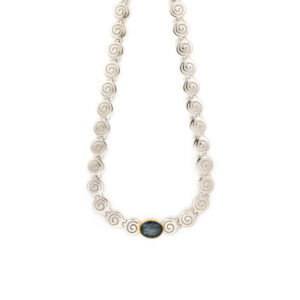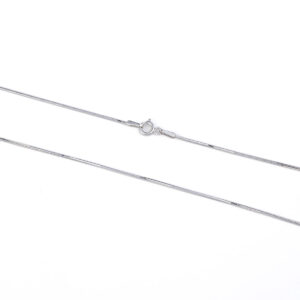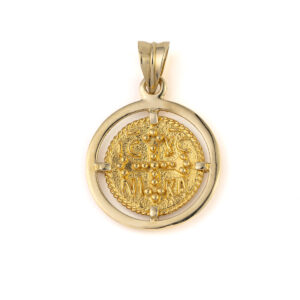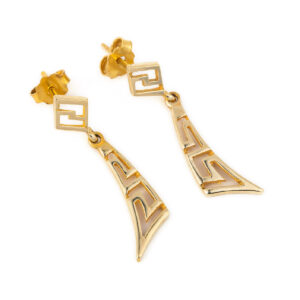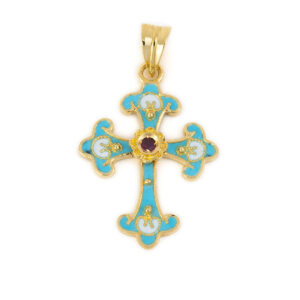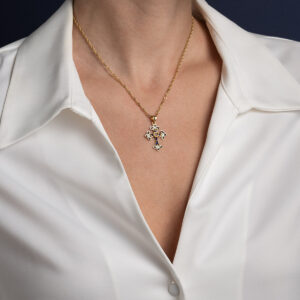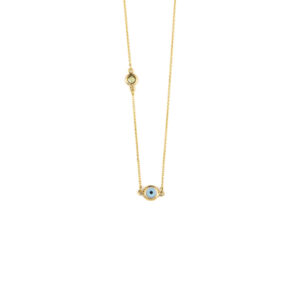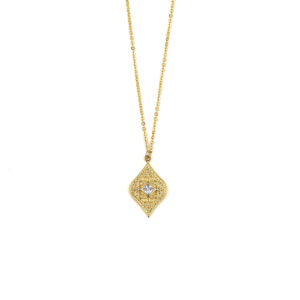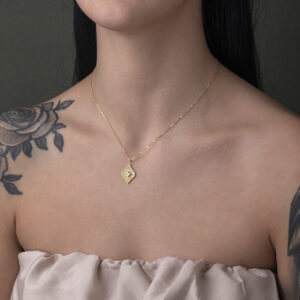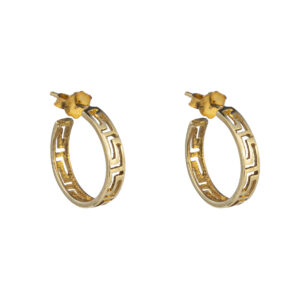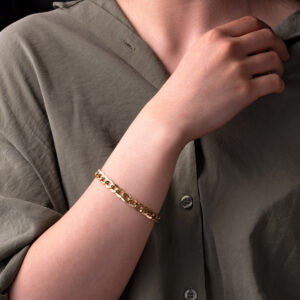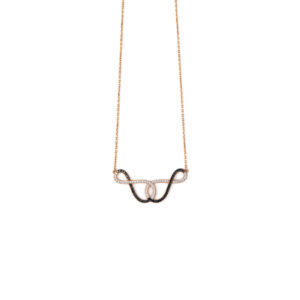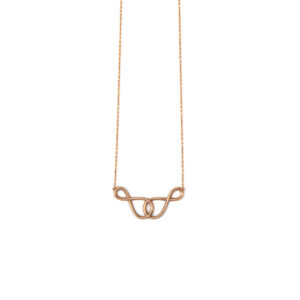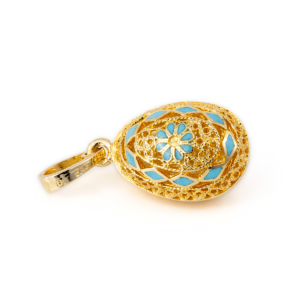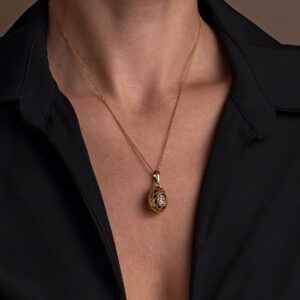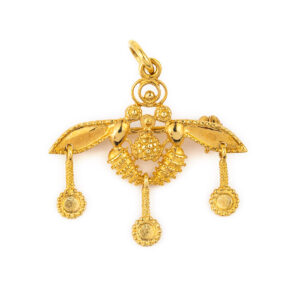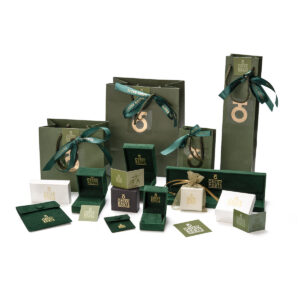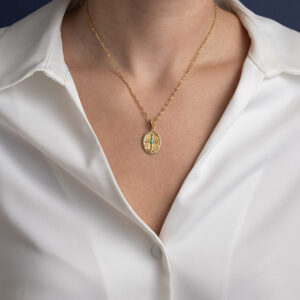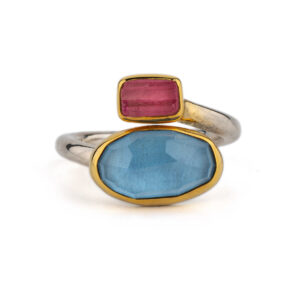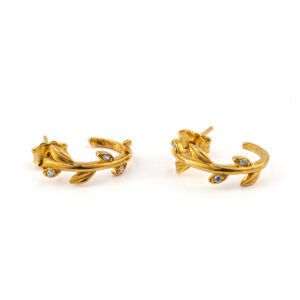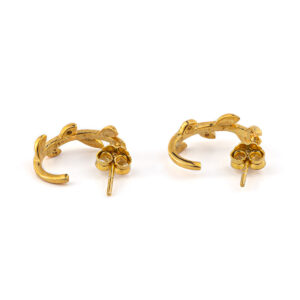14K Gold Zircon Cross
782,00€Beautiful Cross Pendant made of 14K Solid Gold.
Handmade in Greece
Baptism crosses and baptism crucifixes are classic gifts for a child and their parents on the special occasion of a child’s baptism.
Explore Religious Collection
Greek Key Hoop Earrings – 14K Gold
775,00€Made of 14K gold. Handmade in Greece
Explore Meandros Collection
Meandros design is a decorative border constructed from a continuous line, shaped into a repeated motif. Such a design is also called the Greek fret or Greek key design, although these are modern designations. On the one hand, the name “meander” recalls the twisting and turning path of the Meander River in Asia Minor, and on the other hand, as Karl Kerenyi pointed out, “the meander is the figure of a labyrinth in linear form” the meaning is that there is no beginning and no end in some cases so it becomes the symbol of long life and eternity.
Phaistos Disc Pendant in 14K Gold
278,00€ – 772,00€A pendant inspired by the ancient disk found in Phaistos.
Made of 14k gold.
Handmade in Greece.
The chain shown is our 14K Gold Twisted Chain (not included).
Explore Phaistos Disc Collection
History
The Phaistos Disc is a disk of fired clay from the Minoan palace of Phaistos on the island of Crete. Now, the island of Crete is part of modern Greece. The disc was discovered in 1908 by the Italian archaeologist Luigi Pernier in the Minoan palace-site of Phaistos. While it is not clear that it is a script, most attempted decipherments assume that it is; most additionally assume a syllabary, others an alphabet or logography or a calendar.
Meander Polygon Earrings – 14K Gold
772,00€Handmade in Greece
Explore Meandros Collection
Meandros design is a decorative border constructed from a continuous line, shaped into a repeated motif. Such a design is also called the Greek fret or Greek key design, although these are modern designations. On the one hand, the name “meander” recalls the twisting and turning path of the Meander River in Asia Minor, and on the other hand, as Karl Kerenyi pointed out, “the meander is the figure of a labyrinth in linear form” the meaning is that there is no beginning and no end in some cases so it becomes the symbol of long life and eternity.
Constantinato Pendant with Enamel – 14K Gold
772,00€A handmade gold Constantinato pendant that depicts a cross on the one side and Saints Constantine and Helena on the other side.
A unique pendant that you can offer to your special ones as a protection gift or buy it for yourself.
Made of 14k gold.
Handmade in Greece
14K Yellow Gold Evil Eyes Bracelet
772,00€Made in 14K gold.
Handmade in Greece.
Explore Mati Collection
Evil Eye
The symbol and superstition of the evil eye is one of the strongest symbolic images in the world. The earliest known evidence for belief in the evil eye goes back to ancient Greece and Rome. It is supposed to wear off evil to anyone who wears it and various cultures believe in that, however in Greece it’s blue because at that time blue eyes were not so common and were thought to give the evil eye, so the blue is like a mirror to them.
Filigree Egg Pendant with Flowers – 14k Gold and Blue Enamel
771,00€The pendant is embellished with fine filigree and blue enamel in Faberge style.
Used as a charm or as a pendant.
Pick up a beautiful gift inspired by the majestic art of Fabergé!
Made in 14k yellow gold
Filigree is a delicate kind of jewelry metalwork, made with tiny beads or twisted threads, or both in combination, soldered together or to the surface of an object of the same metal and arranged in artistic motifs. The art of filigree dates back to ancient history. The first of the found jewelry in this technique has been found in Mesopotamia and dates to thousands of years BC. In the ancient world and particularly in Asia Minor, this art grew at the highest level.
Rosette The rosette (rose) is a timeless jewel, symbol, and amulet. The origin of the term is the Greek word for rose – rodon (ρόδον). Its use began in the Mycenaean era and continues as far as the 2nd millennia BC. The Mycenaean Rosette is a motif that was widespread throughout Mesopotamia, Egypt, Greece, and other ancient civilizations. Rosette or Rodax was probably the most popular and favorite decorative element in the Mycenaean era, classical antiquity, and Byzantine times.
Fabergé egg is a jeweled egg created by the House of Fabergé, in St. Petersburg, Imperial Russia. Virtually all were manufactured under the supervision of Peter Carl Fabergé between 1885 and 1917,[citation needed] the most famous being the 50 “Imperial” eggs, 43 of which survive, made for the Russian Tsars Alexander III and Nicholas II as Easter gifts for their wives and mothers. The first Fabergé egg was crafted for Tsar Alexander III, who had decided to give his wife, Empress Maria Feodorovna, an Easter egg in 1885. Peter Carl Fabergé was a Russian jeweller best known for the famous Fabergé eggs made in the style of genuine Easter eggs, using precious metals and gemstones. He’s the founder of the famous jewelry legacy House of Fabergé.
14K Yellow Gold Greek Key Hoop Earrings
729,00€ – 762,00€Made of 14K gold.
Handmade in Greece
Explore Meandros Collection
Meandros design is a decorative border constructed from a continuous line, shaped into a repeated motif. Such a design is also called the Greek fret or Greek key design, although these are modern designations. On the one hand, the name “meander” recalls the twisting and turning path of the Meander River in Asia Minor, and on the other hand, as Karl Kerenyi pointed out, “the meander is the figure of a labyrinth in linear form” the meaning is that there is no beginning and no end in some cases so it becomes the symbol of long life and eternity.
Olive Leaf Branch Ring – 18K Solid Yellow Gold
756,00€Ring inspired by the olive leaf symbol.
Made of 18k gold.
The olive wreath also known as kotinos was the prize for the winner at the ancient Olympic Games. It was an olive branch, of the wild- olive tree that grew at Olympia, intertwined to form a circle or a horse-shoe. According to Pausanias it was introduced by Heracles as a prize for the running race winner to honour his father Zeus. In the ancient Olympic Games there were no gold, silver, or bronze medals. There was only one winner per event, crowned with an olive wreath made of wild-olive leaves from a sacred tree near the temple of Zeus at Olympia. Olive wreaths were given out during the 2004 Summer Olympics in Athens in honor of the ancient tradition, because the games were being held in Greece.
Eye Chain Bracelet – 14K Gold
749,00€Made of 14K yellow gold
Handmade in Greece
The symbol and superstition of the evil eye is one of the strongest symbolic images in the world. The earliest known evidence for belief in the evil eye goes back to ancient Greece and Rome. It is supposed to wear off evil to anyone who wears it.
18K Gold Byzantine Filigree Emerald Cross
742,00€Byzantine Cross embellished with a fine filigree, an emerald gemstone in the middle and granules of precious metal.
Handmade with great attention to detail. Inspired by Byzantine art.
Made in 18k gold
Filigree is a delicate kind of jewellery metalwork, made with tiny beads or twisted threads, or both in combination, soldered together or to the surface of an object of the same metal and arranged in artistic motifs. The art of filigree dates back to ancient history. The first of the found jewelry in this technique has been found in Mesopotamia and dates to thousands of years BC. In the ancient world and particularly in Asia Minor, this art grew at the highest level.
Explore Religious Collection
18K Gold Byzantine Filigree Ruby Cross
742,00€Byzantine Cross embellished with a fine filigree and a ruby gemstone in the middle.
Handmade with great attention to detail. Inspired by Byzantine art.
Made in 18k gold.
The chain shown in the second photo is our Twisted Chain 14k Gold (not included)
Explore Religious Collection
Filigree is a delicate kind of jewellery metalwork, made with tiny beads or twisted threads, or both in combination, soldered together or to the surface of an object of the same metal and arranged in artistic motifs. The art of filigree dates back to ancient history. The first of the found jewelry in this technique has been found in Mesopotamia and dates to thousands of years BC. In the ancient world and particularly in Asia Minor, this art grew at the highest level.
Filigree Cross with Stone in 18K Gold
742,00€Byzantine Cross embellished with a fine filigree and a sapphire gemstone in the middle.
Handmade with great attention to detail. Inspired by Byzantine art.
Made in 18k gold.
The chain shown is our 14K Gold Spiga Chain (not included)
Explore Religious Collection
Filigree is a delicate kind of jewellery metalwork, made with tiny beads or twisted threads, or both in combination, soldered together or to the surface of an object of the same metal and arranged in artistic motifs. The art of filigree dates back to ancient history. The first of the found jewelry in this technique has been found in Mesopotamia and dates to thousands of years BC. In the ancient world and particularly in Asia Minor, this art grew at the highest level.
Enamel Goddess Athena Coin Pendant – 14K Gold
728,00€Α beautiful and elegant Coin Pendant with Goddess Athena
The front side of this pendant is decorated with Goddess Athena and the back side is decorated with the wisdom owl
Made in 14k gold and blue enamel.
Handmade in Greece.
The chain shown is our 14K Gold Chain (not included).
Explore Coins Collection
Goddess Athena and Owl – Athenian silver tetradrachm
Dracma was the currency used in Greece during several periods in its history.
The tetradrachm was an Ancient Greek silver coin equivalent to fourdrachmae in Athens it replaced the earlier “heraldic” type of didrachms and it was in wide circulation from ca. 510 to ca. 38 BC.
This coin belongs to the so-called “new style Athenian coins” minted between 166 and 64 B.C. and is considered one of the most popular ancient Greek coins which illustrate the portrait of Goddess Athena on the one side and the wisdom owl on the other. Athena is an ancient Greek goddess associated with wisdom, handicraft, and warfare.
Athena was regarded as the patron and protectress of various cities across Greece, particularly the city of Athens, from which she most likely received her name. She’s usually shown in art wearing a helmet and holding a spear. Her major symbols include owls, olive trees, and snakes. Her temples were located atop the fortified Acropolis in the central part of the city. The Parthenon on the Athenian Acropolis is dedicated to her, along with numerous other temples and monuments. Her main festival in Athens was the Panathenaia, which was celebrated in midsummer and was the most important festival on the Athenian calendar.
In the classical Olympian pantheon, Athena was regarded as the favorite daughter of Zeus. The owl traditionally accompanies Athena. Because of such association, the owl has been used as a symbol of knowledge and wisdom. The inscriptions contain the city’s “national” appellation (“ΑΘΕ», i.e. “of the Athenians”).
As in all handmade items there may be small differences in weight and dimensions and this is what makes them unique and precious.
14K Gold Ancient Corinthian Greek Column
728,00€Used as a charm on a bracelet or as a pendant on a chain.
Made in 14k gold.
Handmade item.
History
The Corinthian order is named for the Greek city of Corinth, to which it was connected in the period. There are three distinct orders in Ancient Greek architecture: Doric, Ionic, and Corinthian. The Corinthian order is the last developed of the three principal classical orders of ancient Greek and Roman architecture. The Corinthian, with its offshoot the Composite, is the most ornate of the orders. This architectural style is characterized by slender fluted columns and elaborate capitals decorated with acanthus leaves and scrolls. Also there are many variations. The Corinthian Order in 334 BC it appeared as an external feature on the Choragic Monument of Lysicrates in Athens, and then used on a huge scale at the Temple of Zeus Olympia in Athens.
14k Gold Donkey Charm
728,00€14k Gold Donkey Charm
By the second millennium BC, the donkey was brought to Europe, possibly at the same time as viticulture was introduced, as the donkey is associated with the Syrian god of wine, Dionysus.
Used as a charm on a bracelet or as a pendant on a chain.
Handmade item.
The chain shown is our 14K Gold Chain in Length 40cm (not included).
Byzantine Filigree Cross in 18K Gold with Pearl
716,00€The cross is embellished with a fine filigree and pearl.
Inspired by Byzantine art.
Made in 18k gold
Handmade item.
Filigree is a delicate kind of jewellery metalwork, made with tiny beads or twisted threads, or both in combination, soldered together or to the surface of an object of the same metal and arranged in artistic motifs. The art of filigree dates back to ancient history. The first of the found jewelry in this technique has been found in Mesopotamia and dates to thousands of years BC. In the ancient world and particularly in Asia Minor, this art grew at the highest level.
Constantinato Cross Pendant in 14K Yellow Gold
220,00€ – 708,00€A handmade gold pendant that depicts Saints Constantine and Helena on the one side and Christogram with the initials IC XC NIKA (Jesus Christ conquers) on the other side.
Is a unique pendant which you can offer to your special ones as a protection gift or buy it for yourself.
Handmade with great attention to detail.
Made in 14k gold.
The chain shown is our 14K Gold Spiga Chain (not included)
Alexander the Great Pendant – 14K Gold
708,00€Α beautiful and timeless Coin Pendant inspired by the ancient Greek tetradrachm coin of Alexander the Great.
Made of 14k gold.
The chain shown is our 14K Gold Spiga Chain (not included)
This Ancient Greek coin represents Alexander the Great. Alexander the Great the King of Macedonia is considered one of the most important forms of world history.
As in all handmade items, there may be small differences in weight and dimensions and this is what makes them unique and precious.
Goddess Athena and Owl Filigree Pendant – 14K Gold
708,00€This coin illustrates the portrait of Goddess Athena on the one side and the wisdom owl on the other.
Α beautiful and timeless coin pendant.
Made of 14k gold.
The chain shown is our 14K Gold Box Chain in Length 50cm (not included).
Goddess Athena and Owl – Athenian silver tetradrachm.
Dracma was the currency used in Greece during several periods in its history. The tetradrachm was an Ancient Greek silver coin equivalent to fourdrachmae in Athens it replaced the earlier “heraldic” type of didrachms and it was in wide circulation from ca. 510 to ca. 38 BC. This coin belongs to the so-called “new style Athenian coins” minted between 166 and 64 B.C. and is considered one of the most popular ancient Greek coins which illustrate the portrait of Goddess Athena on the one side and the wisdom owl on the other. Athena is an ancient Greek goddess associated with wisdom, handicraft, and warfare. Athena was regarded as the patron and protectress of various cities across Greece, particularly the city of Athens, from which she most likely received her name. She’s usually shown in art wearing a helmet and holding a spear. Her major symbols include owls, olive trees, and snakes. Her temples were located atop the fortified Acropolis in the central part of the city. The Parthenon on the Athenian Acropolis is dedicated to her, along with numerous other temples and monuments. Her main festival in Athens was the Panathenaia, which was celebrated in midsummer and was the most important festival on the Athenian calendar. In the classical Olympian pantheon, Athena was regarded as the favorite daughter of Zeus. The owl traditionally accompanies Athena. Because of such association, the owl has been used as a symbol of knowledge and wisdom. The inscriptions contain the city’s “national” appellation (“ΑΘΕ», i.e. “of the Athenians”). As in all handmade items there may be small differences in weight and dimensions and this is what makes them unique and precious.
Meandros Ring 14K Gold
708,00€Ring inspired by the ancient Greek design of the Meander or Greek Key.
Made of 14K gold
Meandros design is a decorative border constructed from a continuous line, shaped into a repeated motif. Such a design is also called the Greek fret or Greek key design, although these are modern designations. On the one hand, the name “meander” recalls the twisting and turning path of the Meander River in Asia Minor, and on the other hand, as Karl Kerenyi pointed out, “the meander is the figure of a labyrinth in linear form” the meaning is that there is no beginning and no end in some cases so it becomes the symbol of long life and eternity.
As in all handmade items, there may be small differences in weight and dimensions and this is what makes them unique and precious.
18K Gold Byzantine Filigree Sapphire Earrings
705,00€Byzantine Earrings embellished with a fine filigree and a sapphire gemstone in the middle.
Handmade with great attention to detail. Inspired by Byzantine art.
Made in 18k gold
Filigree is a delicate kind of jewellery metalwork, made with tiny beads or twisted threads, or both in combination, soldered together or to the surface of an object of the same metal and arranged in artistic motifs. The art of filigree dates back to ancient history. The first of the found jewelry in this technique has been found in Mesopotamia and dates to thousands of years BC. In the ancient world and particularly in Asia Minor, this art grew at the highest level.
Byzantine Filigree Sapphire Cross in 18K Gold
689,00€Byzantine Cross embellished with a fine filigree and a sapphire gemstone in the middle.
Handmade with great attention to detail. Inspired by Byzantine art.
Made in 18k gold
Filigree is a delicate kind of jewellery metalwork, made with tiny beads or twisted threads, or both in combination, soldered together or to the surface of an object of the same metal and arranged in artistic motifs. The art of filigree dates back to ancient history. The first of the found jewelry in this technique has been found in Mesopotamia and dates to thousands of years BC. In the ancient world and particularly in Asia Minor, this art grew at the highest level.
18K Gold Filigree Cross with Emerald
689,00€Byzantine Cross embellished with a fine filigree, an emerald gemstone in the middle and granules of precious metal.
Handmade with great attention to detail. Inspired by Byzantine art.
Made in 18k gold.
The chain shown in the second photo is our Twisted Chain 14k Gold (not included).
The chain shown in the fourth photo is our 14K Gold Rope Chain (not included).
Filigree is a delicate kind of jewellery metalwork, made with tiny beads or twisted threads, or both in combination, soldered together or to the surface of an object of the same metal and arranged in artistic motifs. The art of filigree dates back to ancient history. The first of the found jewelry in this technique has been found in Mesopotamia and dates to thousands of years BC. In the ancient world and particularly in Asia Minor, this art grew at the highest level.
Explore Religious Collection
Minoan Malia Bees Dangle Earrings – 14K Solid Yellow Gold
684,00€Dangle earrings inspired by the ancient Minoan Greek Malia bees pendant.
Made of 14K Gold.
Handmade item.
The Minoan Bees Pendant, one of the most famous Minoan artworks, was discovered in the Old Palace cemetery at Chrysolakkos, outside the palace of Malia, the third largest and most significant known Minoan palace after Knossos and Phaistos. Chryssolakkos means the “Pit of gold” because of the many precious objects that were found there. The famous pendant dates back to the Bronze Age, (1800 BC) and it’s a stunning, very detailed representation of two bees or wasps storing away a drop of honey in their honeycomb. This pendant is one of the most famous exhibits in the wonderfully Heraklion archeological museum.
As in all handmade items, there may be small differences in weight and dimensions and this is what makes them unique and precious.
Blue Topaz Peridot Ring – 18K Gold and 925 Sterling Silver
680,00€Ring with blue topaz and peridot.
Made of 18K Gold and 925 Sterling Silver
Handmade in Greece
As in all handmade items there may be small differences in weight, dimensions and this is what makes them unique and precious.
Explore Ionian Colors Collection
The collection contains jewelry with unique semi precious stones in beautiful colors.
Olive Branch Ring – 18K Solid Yellow Gold
680,00€Ring inspired by the olive leaf symbol.
Made of 18k gold.
The olive wreath also known as kotinos was the prize for the winner at the ancient Olympic Games. It was an olive branch, of the wild- olive tree that grew at Olympia, intertwined to form a circle or a horse-shoe. According to Pausanias it was introduced by Heracles as a prize for the running race winner to honour his father Zeus. In the ancient Olympic Games there were no gold, silver, or bronze medals. There was only one winner per event, crowned with an olive wreath made of wild-olive leaves from a sacred tree near the temple of Zeus at Olympia. Olive wreaths were given out during the 2004 Summer Olympics in Athens in honor of the ancient tradition because the games were being held in Greece.
Gold 18K Byzantine Rosette Stud Earrings
504,00€ – 680,00€Byzantine Earrings which have the shape of the flower rosette.
Handmade with great attention to detail. Inspired by Byzantine art.
Made in 18k gold
Rosette flower
The rosette (rose) is a timeless jewel, symbol and amulet. The origin of the term is the Greek word for rose – rodon (ρόδον). Its use began in the Mycenaean era and continues as far as the 2nd millennia BC. The Mycenaean Rosette is a motif that was widespread throughout Mesopotamia, Egypt, Greece and other ancient civilizations. It is inspired by a Mycenaean rosette bead, found at Mycenae, dated to 1400-1300 B.C. The rosette was used extensively in ancient Greek Mycenaean jewels, in architecture, pottery and in sculptures from 1500 BC. Mycenaean rosettes usually had 6 or 8 or 12 leaves, and sixteen leaves during the Macedonian Dynasty. Such details as the rodax shape and the number of leaves tend to vary with the era or beliefs. The rosettes were used to decorate the cloths, belts and wreaths of the Kings. The number of leaves had a symbolic character each time. The four elements of nature (wind, earth, fire, water), the seven wonders of the ancient world or the twelve gods of ancient Greeks and the world domination and radiance of the Kings of Macedonia. They were signs of beauty, purity, eugenics, worship and power. Rosette or Rodax was probably the most popular and favorite decorative element in Mycenaean era, classical antiquity and Byzantine times.
Lapis Lazuli Spiral Necklace- 14K Gold and 925 Sterling Silver
This stunning necklace features a lapis lazuli stone.
Made of 925 sterling silver and 14k gold.
Handmade item. As in all handmade items there may be small differences in weight and dimensions and this is what makes them unique and precious.
Constantinato Pendant – Gold 14K
665,00€A handmade gold Constantinato pendant that depicts a cross on the one side and Saints Constantine and Helena on the other side.
A unique pendant that you can offer to your special ones as a protection gift or buy it for yourself.
Made of 14k gold.
Handmade in Greece.
The chain shown is not included.
14K Gold Geometrical Meander Earrings
665,00€Made in 14k gold.
Explore Meandros Collection
Meandros design is a decorative border constructed from a continuous line, shaped into a repeated motif. Such a design is also called the Greek fret or Greek key design, although these are modern designations. On the one hand, the name “meander” recalls the twisting and turning path of the Meander River in Asia Minor, and on the other hand, as Karl Kerenyi pointed out, “the meander is the figure of a labyrinth in linear form” the meaning is that there is no beginning and no end in some cases so it becomes the symbol of long life and eternity.
18K Gold and Enamel Byzantine Ruby Cross
655,00€Byzantine Cross embellished with turquoise and white enamel, and a rosette flower in the center which is decorated with a ruby and granules of precious metal.
The back side of the cross has no decoration. Available with green, red and green enamel. Choose your preferred enamel color.
Handmade with great attention to detail. Inspired by Byzantine art.
Made in 18k gold
Explore Religious Collection
Filigree is a delicate kind of jewellery metalwork, made with tiny beads or twisted threads, or both in combination, soldered together or to the surface of an object of the same metal and arranged in artistic motifs. The art of filigree dates back to ancient history. The first of the found jewelry in this technique has been found in Mesopotamia and dates to thousands of years BC. In the ancient world and particularly in Asia Minor, this art grew at the highest level.
Rosette flower
The rosette (rose) is a timeless jewel, symbol and amulet. The origin of the term is the Greek word for rose – rodon (ρόδον). Its use began in the Mycenaean era and continues as far as the 2nd millennia BC. The Mycenaean Rosette is a motif that was widespread throughout Mesopotamia, Egypt, Greece and other ancient civilizations. It is inspired by a Mycenaean rosette bead, found at Mycenae, dated to 1400-1300 B.C. The rosette was used extensively in ancient Greek Mycenaean jewels, in architecture, pottery and in sculptures from 1500 BC. Mycenaean rosettes usually had 6 or 8 or 12 leaves, and sixteen leaves during the Macedonian Dynasty. Such details as the rodax shape and the number of leaves tend to vary with the era or beliefs. The rosettes were used to decorate the cloths, belts and wreaths of the Kings. The number of leaves had a symbolic character each time. The four elements of nature (wind, earth, fire, water), the seven wonders of the ancient world or the twelve gods of ancient Greeks and the world domination and radiance of the Kings of Macedonia. They were signs of beauty, purity, eugenics, worship and power. Rosette or Rodax was probably the most popular and favorite decorative element in Mycenaean era, classical antiquity and Byzantine times.
Constantinato Pendant with Enamel and Turquoise – 14K Gold
654,00€A handmade gold Constantinato pendant that depicts a cross on the one side and Saints Constantine and Helena on the other side.
A unique pendant that you can offer to your special ones as a protection gift or buy it for yourself.
Made of 14k gold.
Handmade in Greece
Eye Circle Necklace – 14K Gold
642,00€Made of 14K yellow gold
Handmade in Greece
The symbol and superstition of the evil eye is one of the strongest symbolic images in the world. The earliest known evidence for belief in the evil eye goes back to ancient Greece and Rome. It is supposed to wear off evil to anyone who wears it.
Meander Hoop Earrings – 14K Gold
364,00€ – 642,00€Handmade in Greece
Explore Meandros Collection
Meandros design is a decorative border constructed from a continuous line, shaped into a repeated motif. Such a design is also called the Greek fret or Greek key design, although these are modern designations. On the one hand, the name “meander” recalls the twisting and turning path of the Meander River in Asia Minor, and on the other hand, as Karl Kerenyi pointed out, “the meander is the figure of a labyrinth in linear form” the meaning is that there is no beginning and no end in some cases so it becomes the symbol of long life and eternity.
Greek Key Chain Bracelet – 14K Gold
642,00€Chain bracelet with continuous Greek key design the which symbolizes long life and eternity.
A meander or meandros is a decorative border constructed from a continuous line, shaped into a repeated motif. Such a design is also called the Greek fret or Greek key design, although these are modern designations. On the one hand, the name “meander” recalls the twisting and turning path of the Meander River in Asia Minor, and on the other hand the meander is the figure of a labyrinth in linear form. Meander was among the most important symbols in ancient Greece; they, perhaps, symbolized infinity and unity; many ancient Greek temples incorporated the sign of the meander.
Made of 14k gold.
Handmade item
Filigree Egg Pendant with Rosette Flower – 14k Gold and Turquoise Enamel
642,00€The pendant is embellished with a fine filigree and turquoise enamel.
Used as a charm or as a pendant.
Pick up a beautiful gift inspired by the majestic art of Fabergé!
Made in 14k yellow gold
Filigree is a delicate kind of jewellery metalwork, made with tiny beads or twisted threads, or both in combination, soldered together or to the surface of an object of the same metal and arranged in artistic motifs. The art of filigree dates back to ancient history. The first of the found jewelry in this technique have been found in Mesopotamia and dates to thousands of years BC. In the ancient world and particularly in Asia Minor, this art grew were at the highest level.
Rosette The rosette (rose) is a timeless jewel, symbol and amulet. The origin of the term is the Greek word for rose – rodon (ρόδον). Its use began in the Mycenaean era and continues as far as the 2nd millennia BC. The Mycenaean Rosette is a motif that was widespread throughout Mesopotamia, Egypt, Greece and other ancient civilizations. Rosette or Rodax was probably the most popular and favorite decorative element in Mycenaean era, classical antiquity and Byzantine times.
Fabergé egg is a jeweled egg created by the House of Fabergé, in St. Petersburg, Imperial Russia. Virtually all were manufactured under the supervision of Peter Carl Fabergé between 1885 and 1917,[citation needed] the most famous being the 50 “Imperial” eggs, 43 of which survive, made for the Russian Tsars Alexander III and Nicholas II as Easter gifts for their wives and mothers. The first Fabergé egg was crafted for Tsar Alexander III, who had decided to give his wife, the Empress Maria Feodorovna, an Easter egg in 1885. Peter Carl Fabergé was a Russian jeweller best known for the famous Fabergé eggs made in the style of genuine Easter eggs, using precious metals and gemstones. He’s the founder of the famous jewelry legacy House of Fabergé. (wikipedia)
As in all handmade items there may be small differences in weight and dimensions and this is what makes them unique and precious.
14k Gold Minoan Bees Pendant
642,00€Greek Ancient Minoan Bees Pendant In 14k Gold. The Malia honeybee pendant was discovered at Chryssolakkos, of the Minoan Palace of Malia on the island of Crete, and is thought to date to c.1800 BC. The name Chryssolakkos means the “pit of gold” because of the precious objects that the farmers used to find there. The Minoan Palace is situated 3 km east of Malia town and is the third most significant known Minoan Palace after Knossos and Phaistos.
This pendant is in the shape of two bees, or wasps, storing away a drop of honey in a comb.
Made in 14k yellow gold
Handmade item.
14k Gold Phaistos Disc Pendant
342,00€ – 642,00€Phaistos Disc Pendant in 14k Gold. The Phaistos Disc is a disk of fired clay from the Minoan palace of Phaistos on the island of Crete. Now, the island of Crete is part of modern Greece. The disc was discovered in 1908 by the Italian archaeologist Luigi Pernier in the Minoan palace-site of Phaistos. While it is not clear that it is a script, most attempted decipherments assume that it is; most additionally assume a syllabary, others an alphabet or logography or a calendar.
Handmade item.
Zircon Evil Eye Necklace – 9K Gold
640,00€Made of 9K gold.
Handmade in Greece.
Explore Mati Collection
Evil Eye
The symbol and superstition of the evil eye is one of the strongest symbolic images in the world. The earliest known evidence for belief in the evil eye goes back to ancient Greece and Rome. It is supposed to wear off evil to anyone who wears it and various cultures believe in that, however in Greece it’s blue because at that time blue eyes were not so common and were thought to give the evil eye, so the blue is like a mirror to them.
18K Gold Filigree Byzantine Cross
628,00€Byzantine Cross embellished with a fine filigree.
Handmade with great attention to detail. Inspired by Byzantine art.
Made in 18k gold
Filigree is a delicate kind of jewellery metalwork, made with tiny beads or twisted threads, or both in combination, soldered together or to the surface of an object of the same metal and arranged in artistic motifs. The art of filigree dates back to ancient history. The first of the found jewelry in this technique has been found in Mesopotamia and dates to thousands of years BC. In the ancient world and particularly in Asia Minor, this art grew at the highest level.
Constantinato Oval Pendant with Turquoise – Gold 14K
624,00€A handmade gold Constantinato pendant that depicts a cross on the one side and Saints Constantine and Helena on the other side.
A unique pendant that you can offer to your special ones as a protection gift or buy it for yourself.
Made of 14k gold.
Handmade in Greece.
The chain shown is not included.
Aqua Marine and Tourmaline Ring – 18K Gold and 925 Sterling Silver
620,00€Ring with aqua marine and tourmaline
Made of 18K Gold and 925 Sterling Silver
Handmade in Greece
As in all handmade items there may be small differences in weight, dimensions and this is what makes them unique and precious.
Explore Ionian Colors Collection
The collection contains jewelry with unique semi precious stones in beautiful colors.
Olive Leaves Earrings with Zircon – 14K Solid Yellow Gold
620,00€Earrings inspired by the olive leaf symbol.
Made of 14k gold with zircon.
The olive wreath also known as kotinos was the prize for the winner at the ancient Olympic Games. It was an olive branch, of the wild- olive tree that grew at Olympia, intertwined to form a circle or a horse-shoe. According to Pausanias it was introduced by Heracles as a prize for the running race winner to honour his father Zeus. In the ancient Olympic Games there were no gold, silver, or bronze medals. There was only one winner per event, crowned with an olive wreath made of wild-olive leaves from a sacred tree near the temple of Zeus at Olympia. Olive wreaths were given out during the 2004 Summer Olympics in Athens in honor of the ancient tradition, because the games were being held in Greece.

